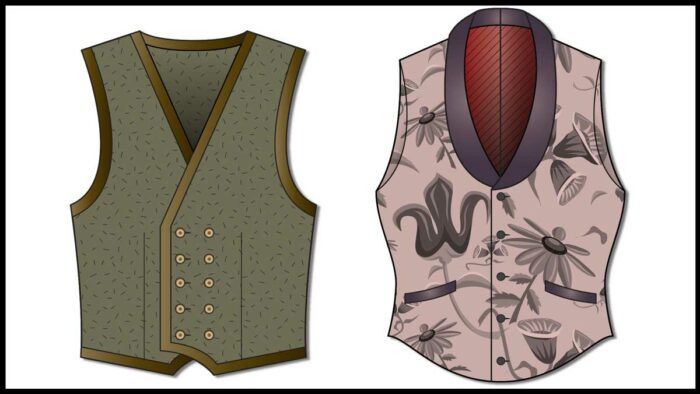
READERS’ QUESTIONS – EXPERT ANSWERS
Q: Can you help me with fitting adjustments for people with scoliosis or other body curvatures? My son has extremely uneven shoulders, different length sides, a very flat chest, and arms that are 10 cm [nearly 4 inches] longer than average. I can lengthen a pattern’s sleeves, but I haven’t figured out how to fit a garment for him. Also, his neck is not directly above his trouser button. I would like to make him a fitted waistcoat but I am really struggling.
—Lucie Nicholson, via email
A: We consulted with fitting expert Kenneth D. King, author of Smart Fitting Solutions (The Taunton Press, 2018), on how to address the challenges of a noticeably asymmetrical body.
One way to create a truly custom fit is to draft a full pattern based on your son’s measurements. You would measure
and draft each side and join the pieces at center front
and center back.
If you are not confident in drafting from measurements, another approach is to follow Judith Neukam’s instructions for adjusting the shoulder slope on a pattern. Her video “Fitting: Key Pattern Adjustments” at ThreadsMagazine.com shows how to make this initial change.
Once you’ve raised, lowered, or changed the angle of the shoulder seams to fit your son, make a muslin. Draw intersecting horizontal balance lines (HBLs) and grainlines on each pattern piece; you’ll use these to fit the muslin. Put the muslin on your son and pin it closed with the center-front lines aligned. If the shoulder adjustment worked, the garment is sitting properly on his shoulders.
Observe how the balance lines are hanging and look for obvious drag lines. Your goal is to manipulate the muslin until the HBLs are parallel to the floor. To achieve this, you’ll probably have to pin uneven tucks across the garment to bring up the lower side. You may need to redraw the bottom of the armhole or make other changes. Check that the HBLs are truly horizontal from front to back, as well: With spinal curvature, garments tend to hang forward or back at bit. Pin vertical darts if they help smooth the fit. Again, with scoliosis, the back can be fuller or more rounded on one side than the other, so these darts can compensate for the imbalance. If your son’s shoulder blades protrude unevenly, consider adding a center-back seam to have another place to make adjustments.
The fitting process can take a few rounds. Do your best in the first fitting, then transfer the pinned or marked changes to the pattern. Make another muslin and see how it looks. You may need to do this two or three times.
If your son’s head and center waist are not on a plumb vertical line, you’ll have to choose between having the waistcoat’s center front be straight on his body—which will look askew to the eye—or vertical relative to the floor. In the second case, it will be off-center in one direction at his neck, and in the other direction at the waist. If it’s less than an inch at either end, it’s unlikely to be noticeable on the body and is a good solution.
I’d also like to offer some style suggestions. First, avoid striped and plaid fabrics—they’ll call attention to the fact that the garment’s edges are not cut on grain, even if it hangs correctly on the body. A textured solid, such as a tweed, or an all-over, organic pattern like paisley or a botanical brocade, can camouflage the off-grain areas.
Next, consider using a double-breasted design and/or one with a shawl collar. Both features bring in additional curves and downplay the center-front vertical line. Once you get a good pattern, you can make further design changes.
This post was originally featured in the Q&A department of Threads #214 (April/May 2021).
Have a Question? Send it to us and we’ll find an expert’s answer.
via mail: Threads Q&A, PO Box 5506, Newtown, CT 06470-5506
via email: ThreadsQ&[email protected]
via the Contact the staff page to submit your entry






























Log in or create an account to post a comment.
Sign up Log in